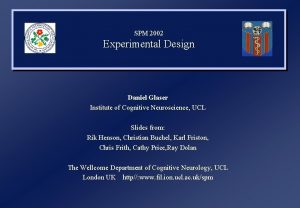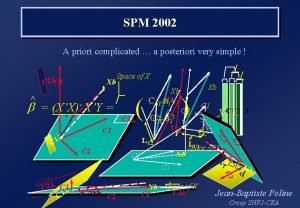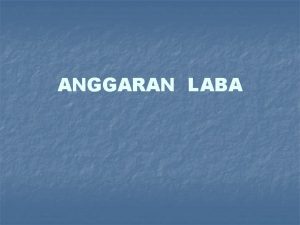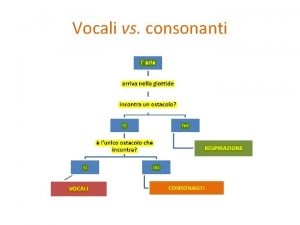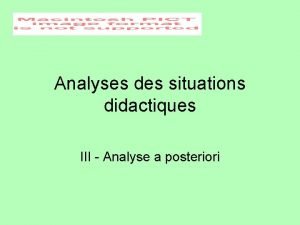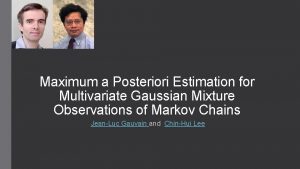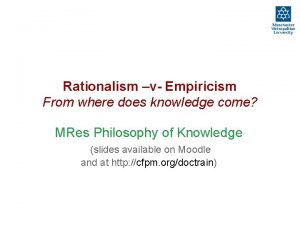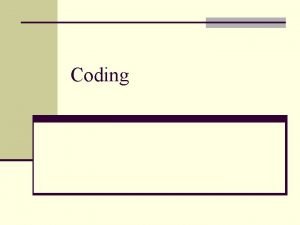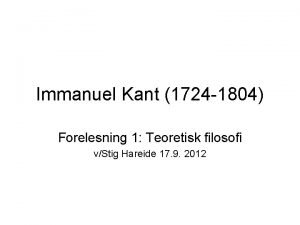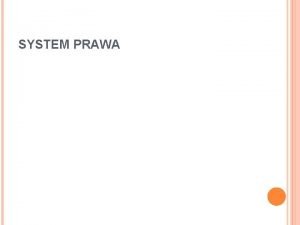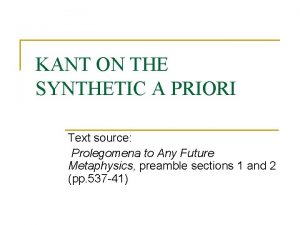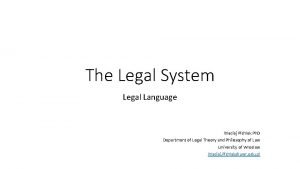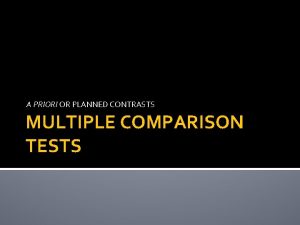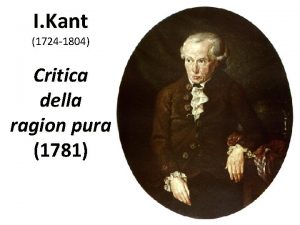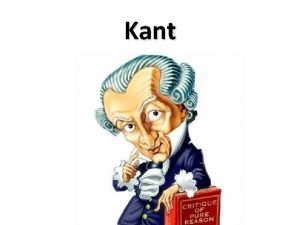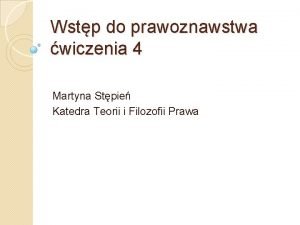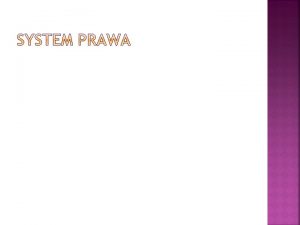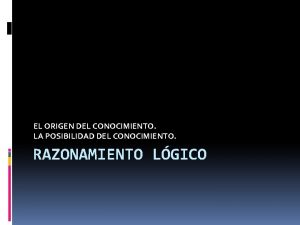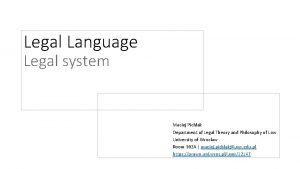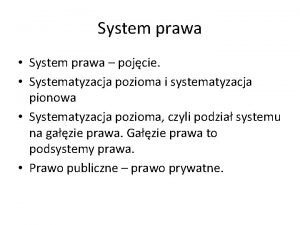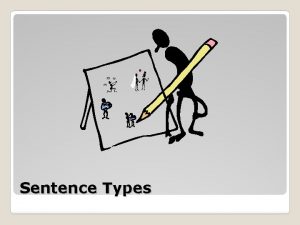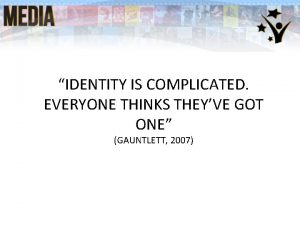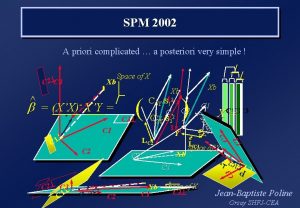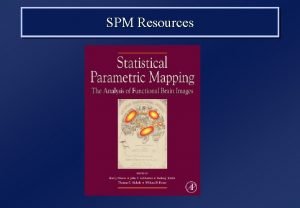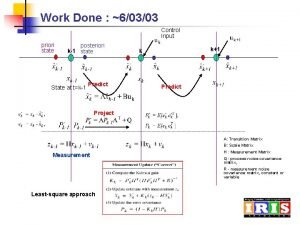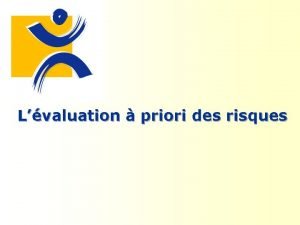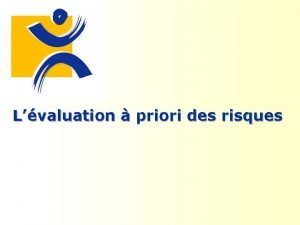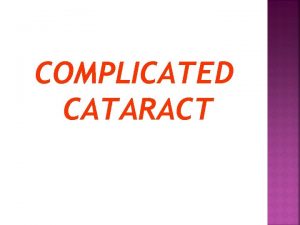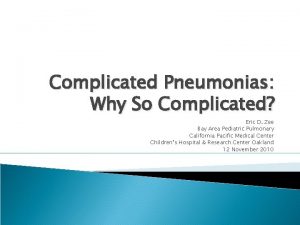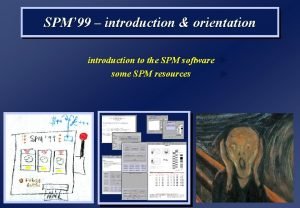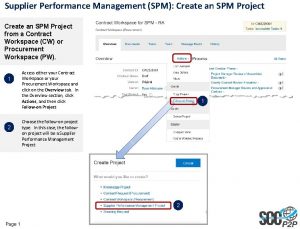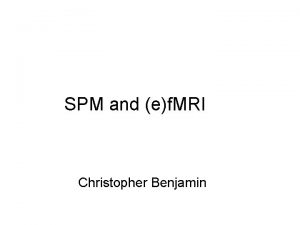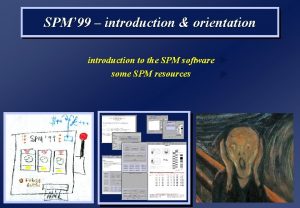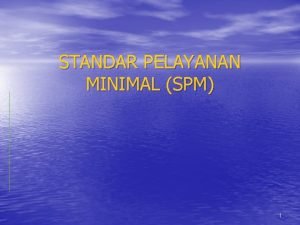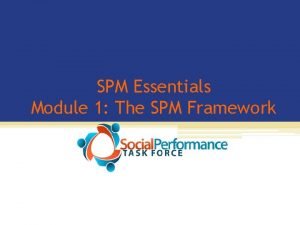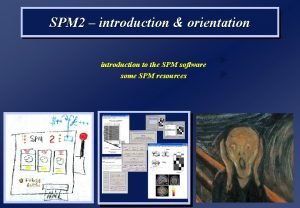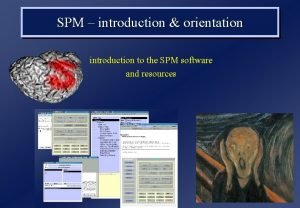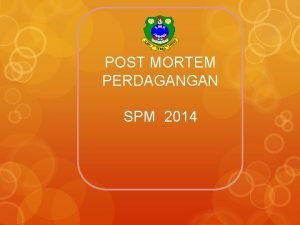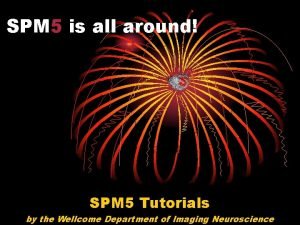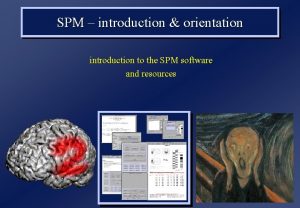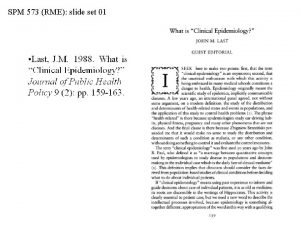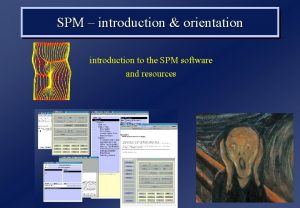SPM 2002 A priori complicated a posteriori very


















![^2 s How is this computed ? (F-test) Estimation [Y, X] [b, s] additional ^2 s How is this computed ? (F-test) Estimation [Y, X] [b, s] additional](https://slidetodoc.com/presentation_image_h/85ed002a244d210cd1e4ae3f5a518a62/image-19.jpg)
























- Slides: 43

SPM 2002 A priori complicated … a posteriori very simple ! C 2 C 1 C 2^ C 3^ C 1 PC ^ Xb 3 1 C C 2 Xb Space of X C 3^ C 1 X = C 3 ^ C 1 ) ( C 2 C 1 X’Y = b = (X’X) C P X Xb ace Sp ^ Xb -3 C 1 Xb Xb ^ 2 L C 1 Y/S 1 C 2 C 1 C 2 C 3 C 12 CC 2 C 3^ 2 Y/S 2 LC 1^ Y e LC 2 LC 1 Space of X Xb C 2 P ^ Xb C 1 ^ ^ C 2 X b C 2^C 3 ^ ^ Space of X Jean-Baptiste Poline Orsay SHFJ-CEA

SPM course - 2002 LINEAR MODELS and CONTRASTS T and F tests : (orthogonal projections) Hammering a Linear Model The RFT Use for Normalisation Jean-Baptiste Poline Orsay SHFJ-CEA www. madic. org

images Design matrix Adjusted signal Your question: a contrast Spatial filter realignement & coregistration smoothing General Linear Model Linear fit Ü statistical image Random Field Theory normalisation Anatomical Reference Statistical Map Uncorrected p-values Corrected p-values

Plan w Make sure we know all about the estimation (fitting) part. . w Make sure we understand the testing procedures : t and F tests w A bad model. . . And a better one w Correlation in our model : do we mind ? w A (nearly) real example

One voxel = One test (t, F, . . . ) amplitude General Linear Model Üfitting Üstatistical image tim e Statistical image (SPM) Temporal series f. MRI voxel time course

Regression example… 90 100 110 -10 0 10 + = a a=1 voxel time series 90 100 110 m -2 0 2 + m = 100 box-car reference function Mean value Fit the GLM

Regression example… 90 100 110 -2 0 2 + = a a=5 m -2 0 2 + m = 100 voxel time series box-car reference function Mean value error

…revisited : matrix form = a Ys = m´ 1 + m + a ´ f(ts) + error + es

Y = = X ´ ´ b r to ec r v ro er s x er ie ri at er et m ra pa m n de sig (v vec ox to el r tim es ta da s) Box car regression: design matrix… a + m + e

Add more reference functions. . . Discrete cosine transform basis functions

Y = X a = b 4 b 5 ´ b s er et ri x + 1 he r v re ec : to r ro er s ( e b et a th = m ra pa at n m de sig r to ec v ta da ) to 9 …design matrix m b 3 + b 6 b 7 b 8 b 9 e

Fitting the model = finding some estimate of the betas = minimising the sum of square of the error S 2 raw f. MRI time series adjusted for low Hz effects fitted box-car fitted “high-pass filter” residuals S the squared values of the residuals number of time points minus the number of estimated betas = s 2

Summary. . . w We put in our model regressors (or covariates) that represent how we think the signal is varying (of interest and of no interest alike) w Coefficients (=estimated parameters or betas) are found such that the sum of the weighted regressors is as close as possible to our data w As close as possible = such that the sum of square of the residuals is minimal w These estimated parameters (the “betas”) depend on the scaling of the regressors : keep in mind when comparing ! w The residuals, their sum of square, the tests (t, F), do not depend on the scaling of the regressors

Plan w Make sure we all know about the estimation (fitting) part. . w Make sure we understand t and F tests w A bad model. . . And a better one w Correlation in our model : do we mind ? w A (nearly) real example

T test - one dimensional contrasts - SPM{t} A contrast = a linear combination of parameters: c´ ´ b c’ = 1 0 0 0 0 box-car amplitude > 0 ? = b 1 > 0 ? (b 1 : estimation of b 1 ) = b 1 b 2 b 3 b 4 b 5. . 1 xb 1 + 0 xb 2 + 0 xb 3 + 0 xb 4 + 0 xb 5 +. . . > 0 ? = test H 0 : c´ ´ b > 0 ? T = contrast of estimated parameters variance estimate c’b T = s 2 c’(X’X)+c SPM{t}

^ b How is this computed ? (t-test) contrast of estimated parameters variance estimate Estimation [Y, X] [b, s] Y = X b + e e ~ s 2 N(0, I) (Y : at one position) b = (X’X)+ X’Y (b = estimation of b) -> beta? ? ? images e = Y - Xb (e = estimation of e) s 2 = (e’e/(n - p)) (s = estimation of s, n: temps, p: paramètres) -> 1 image Res. MS 2 Test [b, s , c] [c’b, t] Var(c’b) = s 2 c’(X’X)+c (compute for each contrast c) t = c’b / sqrt(s 2 c’(X’X)+c) (c’b -> images spm_con? ? ? compute the t images -> images spm_t? ? ? ) under the null hypothesis H 0 : t ~ Student( df ) df = n-p

F test (SPM{F}) : a reduced model or. . . Tests multiple linear hypotheses : Does X 1 model anything ? H 0: True model is X 0 X 0 X 1 additional variance accounted for by tested effects S 2 This model ? S 02 > S 2 Or this one ? F = error variance estimate F ~ ( S 02 - S 2 ) / S 2

F test (SPM{F}) : a reduced model or. . . multi-dimensional contrasts ? tests multiple linear hypotheses. Ex : does HPF model anything? H 0: True model is X 0 X 1 (b 3 -9) H 0: b 3 -9 = (0 0 0 0. . . ) X 0 test H 0 : c´ ´ b = 0 ? 0 0 1 0 0 c’ = 0 0 0 0 1 0 0 0 0 1 c’ = +1 0 0 0 0 SPM{F} This model ? Or this one ?
![2 s How is this computed Ftest Estimation Y X b s additional ^2 s How is this computed ? (F-test) Estimation [Y, X] [b, s] additional](https://slidetodoc.com/presentation_image_h/85ed002a244d210cd1e4ae3f5a518a62/image-19.jpg)
^2 s How is this computed ? (F-test) Estimation [Y, X] [b, s] additional variance accounted for by tested effects Error variance estimate Y = X b + e e ~ N(0, s 2 I) Y = X 0 b 0 + e 0 e 0 ~ N(0, s 02 I) X 0 : X Reduced Estimation [Y, X ] [b , s ] (not really like that ) b = (X ’X )+ X ’Y 0 0 0 0 e 0 = Y - X 0 b 0 (eà = estimation of eà) s 20 = (e 0’e 0/(n - p 0)) (sà = estimation of sà, n: time, pà: parameters) Test [b, s, c] [ess, F] F = (e 0’e 0 - e’e)/(p - p 0) / s 2 -> image (e 0’e 0 - e’e)/(p - p 0) : spm_ess? ? ? -> image of F : spm_F? ? ? under the null hypothesis : F ~ F(df 1, df 2) p - p 0 n-p

Plan w Make sure we all know about the estimation (fitting) part. . w Make sure we understand t and F tests w A bad model. . . And a better one w Correlation in our model : do we mind ? w A (nearly) real example

A bad model. . . True signal and observed signal (---) Model (green, pic at 6 sec) et TRUE signal (blue, pic at 3 sec) Fitting (b 1 = 0. 2, mean =. 11) Noise (still contains some signal) => Test for the green regressor non significant

A bad model. . . b 1= 0. 22 b 2= 0. 11 Residual Variance = 0. 3 = P( b 1 > 0 ) = 0. 1 (t-test) + P( b 1 = 0 ) = 0. 2 (F-test) Y Xb e

A « better » model. . . True signal + observed signal Model (green and red) and true signal (blue ---) Red regressor : temporal derivative of the green regressor Global fit (blue) and partial fit (green & red) Adjusted and fitted signal Noise (a smaller variance) => Test of the green regressor significant => Test F very significant => Test of the red regressor very significant

A better model. . . b 1= 0. 22 b 2= 2. 15 b 3= 0. 11 Residual Var = 0. 2 = P( b 1 > 0 ) = 0. 07 (t test) + P( [b 1 b 2] [0 0] ) = = 0. 000001 (F test) Y X b e

Flexible models : Fourier Basis

Flexible models : Gamma Basis

Summary. . . (2) w The residuals should be looked at. . . (non random structure ? ) w We rather test flexible models if there is little a priori information, and precise ones with a lot a priori information w In general, use the F-tests to look for an overall effect, then look at the betas or the adjusted signal to characterise the origin of the signal w Interpreting the test on a single parameter (one function) can be very confusing: cf the delay or magnitude situation

Plan w Make sure we all know about the estimation (fitting) part. . w Make sure we understand t and F tests w A bad model. . . And a better one w Correlation in our model : do we mind ? w A (nearly) real example ?

Correlation between regressors True signal Model (green and red) Fitting (blue : global fit) Noise

Correlation between regressors b 1= 0. 79 b 2= 0. 85 b 3 = 0. 06 Residual var. = 0. 3 P( b 1 > 0 ) = 0. 08 (t test) = + P( b 2 > 0 ) = 0. 07 (t test) P( [b 1 b 2] 0 ) = 0. 002 = (F test) Y Xb e

Correlation between regressors - 2 true signal Model (green and red) red regressor has been orthogonolised with respect to the green one = remove every thing that can correlate with the green regressor Fit Noise

Correlation between regressors -2 0. 79 b 1= 1. 47 b 2= 0. 85 0. 06 b 3 = 0. 06 Residual var. = 0. 3 P( b 1 > 0 ) = 0. 0003 (t test) = + P( b 2 > 0 ) = 0. 07 (t test) P( [b 1 b 2] <> 0 ) = 0. 002 (F test) Y Xb e See « explore design »

Design orthogonality : « explore design » Black = completely correlated White = completely orthogonal 1 2 Corr(1, 1) Corr(1, 2) 1 2 1 1 2 2 1 2 Beware : when there is more than 2 regressors (C 1, C 2, C 3. . . ), you may think that there is little correlation (light grey) between them, but C 1 + C 2 + C 3 may be correlated with C 4 + C 5

^ C 2 Xb C 1 Implicit or explicit (^) decorrelation (or orthogonalisation) Y Xb e C 2 Space of X C 2 C 1 C 2^ LC 1^ Xb C 1 This GENERALISES when testing several regressors (F tests) See Andrade et al. , Neuro. Image, 1999 LC 2 : test of C 2 in the implicit ^ model LC 1^ : test of C 1 in the explicit ^ model

^ ? b “completely” correlated. . . Y = Xb + e X = 1 0 1 0 1 1 Cond 2 Mean = C 1+C 2 C 1 Parameters are not unique in general ! Some contrasts have no meaning: NON ESTIMABLE Example here : c’ = [1 0 0] is not estimable ( = no specific information in the first regressor); c’ = [1 -1 0] is estimable;

Summary. . . (3) w We are implicitly testing additional effect only, so we may miss the signal if there is some correlation in the model using t tests w Orthogonalisation is not generally needed - parameters and test on the changed regressor don’t change w It is always simpler (when possible !) to have orthogonal (uncorrelated) regressors w In case of correlation, use F-tests to see the overall significance. There is generally no way to decide where the « common » part shared by two regressors should be attributed to w In case of correlation and you need to orthogonolise a part of the design matrix, there is no need to re-fit a new model : the contrast only should change.

Plan w Make sure we all know about the estimation (fitting) part. . w Make sure we understand t and F tests w A bad model. . . And a better one w Correlation in our model : do we mind ? w A (nearly) real example

A real example (almost !) Experimental Design Matrix Factorial design with 2 factors : modality and category 2 levels for modality (eg Visual/Auditory) 3 levels for category (eg 3 categories of words) V A C 1 C 2 C 3 C 1 V A C 2 C 3 C 1 C 2 C 3

Asking ouselves some questions. . . V A C 1 C 2 C 3 2 ways : 1 - write a contrast c and test c’b = 0 2 - select colons of X for the model under the null hypothesis. The contrast manager allows that Test C 1 > C 2 : c = [ 0 0 1 -1 0 0 ] Test V > A : c = [ 1 -1 0 0 ] Test the modality factor : c = ? Use 2 Test the category factor : c = ? Use 2 Test the interaction Mx. C ? • Design Matrix not orthogonal • Many contrasts are non estimable • Interactions Mx. C are not modeled

Modelling the interactions

Asking ouselves some questions. . . C 1 C 2 C 3 V A V A Test C 1 > C 2 : c = [ 1 1 -1 -1 0 0 0] Test V > A : c = [ 1 -1 0] Test the differences between categories : [ 1 1 -1 -1 0 0 0] c = [ 0 0 1 1 -1 -1 0] Test everything in the category factor , leaves out modality : [ 1 1 0 0 0] c = [ 0 0 1 1 0 0 0] [ 0 0 1 1 0] Test the interaction Mx. C ? : [ 1 -1 -1 1 0 0 0] c = [ 0 0 1 -1 -1 1 0] [ 1 -1 0 0 -1 1 0] • Design Matrix orthogonal • All contrasts are estimable • Interactions Mx. C modelled • If no interaction. . . ? Model too “big”

Asking ouselves some questions. . . With a more flexible model C 1 C 2 C 3 V A V A Test C 1 > C 2 ? Test C 1 different from C 2 ? from c = [ 1 1 -1 -1 0 0 0] to c = [ 1 0 -1 0 0 0 0] [ 0 1 0 -1 0 0 0] becomes an F test! Test V > A ? c = [ 1 0 -1 0 0] is possible, but is OK only if the regressors coding for the delay are all equal

SPM course - 2002 LINEAR MODELS and CONTRASTS T and F tests : (orthogonal projections) Hammering a Linear Model The RFT We don’t use that one Use for Normalisation Jean-Baptiste Poline Orsay SHFJ-CEA www. madic. org
 Idealismo de kant
Idealismo de kant A posteriori
A posteriori Priori vs posteriori
Priori vs posteriori Spm 2002
Spm 2002 Spm 2002
Spm 2002 Very bad to very good scale
Very bad to very good scale Very little food
Very little food Scientific notation rules
Scientific notation rules Fewfewfewf
Fewfewfewf Receiving table/area
Receiving table/area Locuciones latinas a priori
Locuciones latinas a priori A posteriori
A posteriori Anggaran laba adalah
Anggaran laba adalah Prograd ufrn
Prograd ufrn Approssimante posteriore
Approssimante posteriore Analyse a posteriori didactique
Analyse a posteriori didactique Maximum a posteriori estimation for multivariate gaussian
Maximum a posteriori estimation for multivariate gaussian Empirism och rationalism
Empirism och rationalism Examples of priori codes
Examples of priori codes A priori vs post hoc
A priori vs post hoc Syntetisk a priori
Syntetisk a priori Luka aksjologiczna przykład
Luka aksjologiczna przykład Synthetic a priori judgments
Synthetic a priori judgments Rivoluzioni copernicane kant
Rivoluzioni copernicane kant Maciej pichlak
Maciej pichlak Planned contrasts
Planned contrasts Giudizi sintetici a priori
Giudizi sintetici a priori Segmentazione a priori
Segmentazione a priori Tetyczne obowiązywanie prawa
Tetyczne obowiązywanie prawa Dialectica de hegel ejemplos
Dialectica de hegel ejemplos Giudizi sintetici a priori
Giudizi sintetici a priori Contexto
Contexto Autopojetyczny
Autopojetyczny Objects of knowledge
Objects of knowledge Lex posterior derogat legi priori
Lex posterior derogat legi priori Apriori machine learning
Apriori machine learning Conocimiento a priori
Conocimiento a priori Maciej pichlak
Maciej pichlak Systematyzacja pionowa
Systematyzacja pionowa A priori
A priori Complicated malaria
Complicated malaria Conjunctions in paragraph
Conjunctions in paragraph Generally restful like a horizontal the sky meets land
Generally restful like a horizontal the sky meets land David gauntlett identity theory quotes
David gauntlett identity theory quotes



